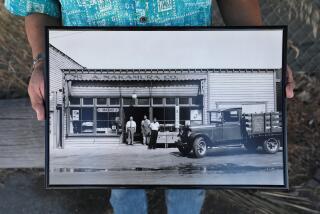LITTLE TOKYO : A Shared History at Internment Camp
- Share via
On Seventh Street in Crystal City, a small Texas town near the Mexican border, the only hint of what happened many years ago is a small, inscribed granite cube.
Most people just drive by. No road signs direct visitors to the historical marker. No listing in the state’s historical directory steers tourists to its out-of-the way location.
Jose Angel Gutierrez, a man whose own history is intertwined with that of the site, figures people are just too embarrassed to remember.
During World War II, 3,000 Japanese Americans were placed in Crystal City’s 290-acre internment camp, which later became a segregated school for Mexican Americans. The cube, designed by the son of a camp prisoner, commemorates the camp, which closed in 1947.
“There is a certain part of our population that says, ‘Why do you want to bring up the ugly?’ “said Gutierrez, who attended the school. “Well, we have to bring up the ugly so we can remain nice people.”
The history of Crystal City will be discussed by a panel Feb. 25 at the Japanese American National Museum. Gutierrez, an associate professor of political science at the University of Texas, and Alan Y. Taniguchi, whose family was interned at the camp, will speak on the panel, which is part of the museum’s yearlong exhibit on concentration camps.
During the war, government officials forced American citizens of Japanese descent and Japanese nationals to move to 11 concentration camps in isolated areas of the West. Although Crystal City is known as an internment camp, few realize that it later became a segregated school.
“There is little known about Crystal City’s relationship to the Latino community,” said Alison Kochiyama, the museum’s program manager.
On Dec. 12, 1942, the camp, once a housing encampment for Latino migrant agricultural workers, opened. At its peak the camp held 3,000 Japanese Americans, 1,000 German nationals and German Americans, and one or two Italian American families.
The camp was the only one to hold non-Japanese residents, said Chris Komai, a museum spokesman.
The camp closed in December, 1947, when many families returned to their pre-war homes or emigrated to Japan.
The internment broke up Alan Taniguchi’s family.
His father, Isamu, was one of about 15 Japanese nationals who farmed in a small northern California town. The father was detained by the FBI in 1942, and later that year, his wife and two sons, along with the other Japanese farming families, were taken to an “assembly center” in Turlock, Calif.
Eventually, Isamu Taniguchi was moved to Crystal City and his family given the option to join him. His wife and youngest son went, but Alan Taniguchi, then 19, opted to live with relatives in Detroit.
“I didn’t want to be taken as being . . . a disloyal American,” said Alan Taniguchi. At the end of the war, Isamu Taniguchi’s family returned to California, but encountered lingering anti-Japanese sentiment. They returned to Texas to farm.
Alan Taniguchi, 72, an Austin-based architect, became involved in recruiting minorities to colleges, and through one of his Latino students, kept in touch with developments of the camp. Eventually, his firm was hired to build schools on the camp site, which is part of the Crystal City Independent School District.
In the late 1940s, the former internment camp was used as a school for Latino migrant workers.
“The segregation that was done was very unique,” said Gutierrez. “It was argued that we were migrants and we could not disrupt the regular programs. And since only Mexican kids migrated, you ended up with Mexican classrooms.”
The discriminatory practice ended in 1969, when Gutierrez helped organize Latino students to stage classroom walkouts asnd demand that. that the mostly white school board make changes. They succeeded. Three years later, an all-Latino school board was elected.
Gutierrez, who served as school board president from 1970-74, said school officials decided to commemorate the internment camp after boxes of school records for Japanese American students in the school’s vault reminded them of the site’s history.
The cube was designed by Taniguchi. It reads in part: “This marker is situated on an original foundation of a two-family cottage as a reminder that the injustice and humiliation suffered here as a result of hysteria, racism, and discrimination never happen again.”
“Crystal City: Past and Present,” will begin at 2 p.m. on Feb. 25 at the Japanese American National Museum, 369 East 1st St., Little Tokyo. Reservations required. $4 admission; free to museum members.
Information: (213) 625-0414.
More to Read
Sign up for Essential California
The most important California stories and recommendations in your inbox every morning.
You may occasionally receive promotional content from the Los Angeles Times.










